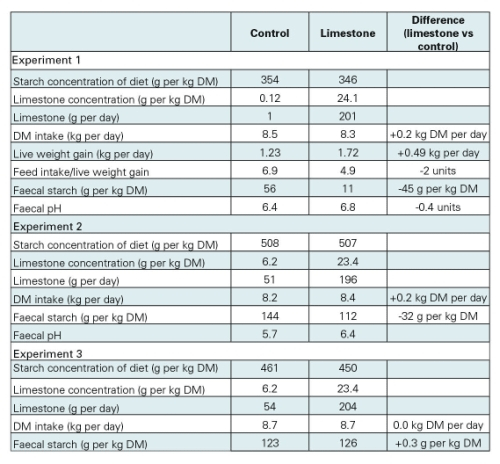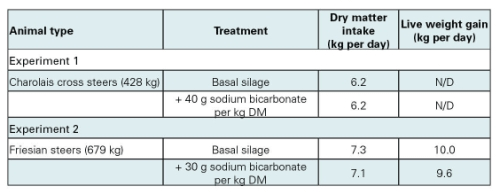



Ground Limestone in Beef Cattle Diets
The purpose of this article is to review existing scientific knowledge on the effect of limestone in ruminant diets, writes Lynne Dawson, Agri-Food and Biosciences Institute.In recent months there has been increased interest in the use of ground limestone in rations for growing and finishing cattle with substantial improvements in animal performance being reported in response to the inclusion of ground limestone in the diet.
High concentrate diets
Extensive research into the effect of buffering agents (including calcium carbonate (ground limestone), sodium bicarbonate and magnesium carbonate), on animal performance has been undertaken in the US from the 1960’s and in the US buffering agents are routinely included in the diets of growing and finishing beef cattle offered high concentrate diets. A summary of the results from a number of studies where ground limestone was incorporated into the diet of beef cattle is presented in Table 1. In Experiment 1, inclusion of limestone increased dry matter intake and live weight gain in trials 1 and 2 but reduced intake and live weight gain in trials 3 and 4. This difference was attributed to the method of application of the limestone. In trials 1 and 2 the limestone was incorporated into the concentrate diet, but in trials 3 and 4 the limestone was sprinkled over the basal ration at the time of feeding. The results from Experiment 2 indicate that increasing levels of limestone resulted in a linear increase in animal performance. However, this result was not statistically significant. In Experiment 3, intake and feed efficiency were reduced in response to limestone supplementation and live weight gain was increased, although again these results were not statistically significant.
Overall, the results of the studies reviewed indicate that there is no clear message on the effect of buffering agents on animal performance and where positive effects on animal performance are obtained the effects were generally small. These findings could be partly explained by the fact that in almost all studies reviewed the control diet contained limestone which ranged from 3 g per kg DM to 10 g per kg DM, so that further addition of limestone had no significant effect. On this basis, information on the ingredient composition of concentrate rations is therefore important to establish whether supplementary limestone is likely to be of benefit.
High starch diets
There is some evidence that buffering agents may be of benefit when offered with diets containing a high concentration of starch or when animals are first being adapted to a high concentrate diet. Animals offered high starch diets have been observed to excrete considerable quantities of starch in the faeces. This effect is associated with low intestinal pH rather than low ruminal pH and an intestinal pH of 6.9 has been shown to produce optimal activity of pancreatic alpha amylase which is responsible for starch digestion. Figur 1 demonstrates that inclusion of ground limestone and magnesium limestone in the diet of beef cattle offered high starch diets (>550 g starch per kg DM), increased pH in all segments of the gastrointestinal tract, but the most dramatic increase was in the small intestine, colon and faeces.

The resultant increase in intestinal pH in response to dietary supplementation with limestone has been linked with improved starch digestion. However as for animal performance parameters, these effects are not consistent between studies. For example, research in dairy heifer calves (Experiment 1 able 2) demonstrated that addition of limestone or magnesium limestone to the diet containing 350 g starch per kg DM, improved intake, liveweight gain and feed efficiency and this was attributed to improved digestion of starch in the intestine. However, in a similar trial with Holstein steers (Experiment 2 Table 2) for diets containing 508 g starch per kg DM, supplementary limestone had no effect on dry matter intake, although starch digestion was improved. As referred to earlier part of this difference could be attributed to the fact that the control diets contained different levels of limestone with much lower levels in the diets in Experiment 1 compared with Experiments 2 and 3.
Silage-based diets
Most research into the effect of addition of limestone on animal performance has been undertaken where animals have been offered high levels of concentrate. In Ireland if there is a perceived low intake problem associated with acid silages, farmers are often advised to add sodium bicarbonate to the silage prior to feeding. However, a review of research data indicates that addition of sodium bicarbonate to grass silage at feeding has no effect on either dry matter intake or animal performance (Table 3). This is supported by research findings in the US which demonstrated that including a buffer in the diet of dairy cows was only of benefit when the basal forage was maize-silage and was included at greater than 30 per cent of the total diet DM. When grass silage or hay were the sole basal forage addition of a buffer to the diet had no effect on dry matter intake or performance. The lack of an effect of buffers on performance of animals offered forage-based diets has been attributed to the fact that forages stimulate secretion of saliva during eating and rumination and coupled with the inherent buffering capacity of the forage maintains rumen pH without the need for supplementary buffers in the diet.
Problems associated with feeding limestone/buffering agents
Some problems have been reported in the scientific literature with cattle consuming diets containing bicarbonate buffers. These include:
- Greater incidence of bloat
- Higher incidence of urinary calculi
- Mineral deficiencies e.g. Vitamin A
Summary and conclusions
- From a review of the scientific literature there is no consistent support for the supplementation of ruminant diets with ground limestone (or other buffering agent).
- For animals offered high-concentrate diets, provided the basal diet contains added limestone (or other buffering agent) there is unlikely to be any response to supplementary limestone. Therefore, check the ingredient (buffer) composition of the concentrate ration being fed prior to considering adding limestone to the diet. Current recommendations for level of inclusion of ground limestone are 1 to 1.5 per cent (DM basis).
- Research evidence indicates that buffering agents are more likely to have an effect in situations where high starch diets are offered although the response obtained depends on the limestone (or other buffering agent) content of the basal ration.
- Animals offered grass-silage-based diets are unlikely to respond to supplementary buffers even when silage pH is low
- Animal health problems have been reported with addition of buffering agents to the diet therefore care needs to taken if adding buffers to ruminant diets
Table 1. Summary of the effect of ground limestone on dry matter intake and performance of beef steers offered high concentrate diets

Table 2. Effect of inclusion of limestone or magnesium limestone on the performance of dairy animals

Table 3. Summary of the effect of buffering agents on the dry matter intake and performance of beef steers offered silage-based diets.

May 2009



